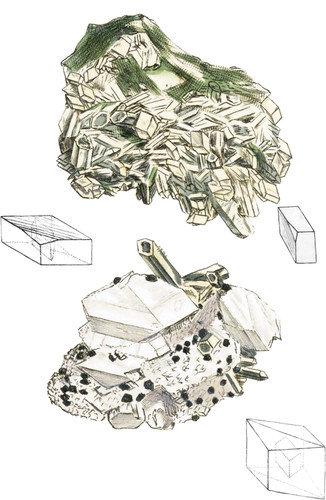 Enlarge
Enlarge
British Mineralogy
Feldspar
The specimens here figured, from Cornwall, are curious, this formation not having till lately been known as British. Such specimens are very rare at present; the crystals not being imbedded, as is most usual; besides which, they much resemble the Feldspar commonly termed Adularia in general habit, although not so transparent as those commonly brought from the place which gave rise to that name. They are, however, whiter and more delicate than usual in those of British origin.
The upper specimen has many small crystals upon it, among Quartz and Chlorite, or Green Talc, which are scattered about the gangue, and occasionally crowded or grouped; but more commonly like the right hand middle figure.
The left hand middle geometrical figure shows the position of the primitive rhomb within the crystal here figured, two prismatic faces of which correspond with it, and the little faces of the corners correspond with the terminal faces of the primitive. The broader striated face forms an angle of about 90° upon the vertical edge of the prism, and the faces of the prism an angle of about 1281/2° upon each other.
The lower figure represents a valuable specimen from Huel Rose mine in the parish of Gwennap, Cornwall, which was lent me by my kind friend John Williams, Esq., who is fortunate in possessing many peculiarly curious Cornish minerals.
The position chosen to show most of this specimen gives it a very strange appearance, especially as so many crystals are situated very close to each other.
The lowest geometrical figure exhibits the position of the nucleus.
The matrix is partly composed of very small crystals of Feldspar, and partly of columnar Quartz crystals, with some irregular six-sided facets., forming the pyramids common to Quartz, which, in these, are often more transparent within than externally, giving them an opaque-coated appearance, depending perhaps on the water of crystallization.
Feldspar is in its forms extremely puzzling, but should be well understood, as we shall be the more likely to know it, if occasion requires, without analysing it, which will facilitate our inquiries into so important a substance, often so very useful in porcelain manufactories.—See tab. 211, 212, and 213.
- Note: In describing the specimen of Adularia, figured in the lower part of plate 257, we have omitted to notice that it is accompanied by small crystals of Oxyde of Tin and Quartz.

